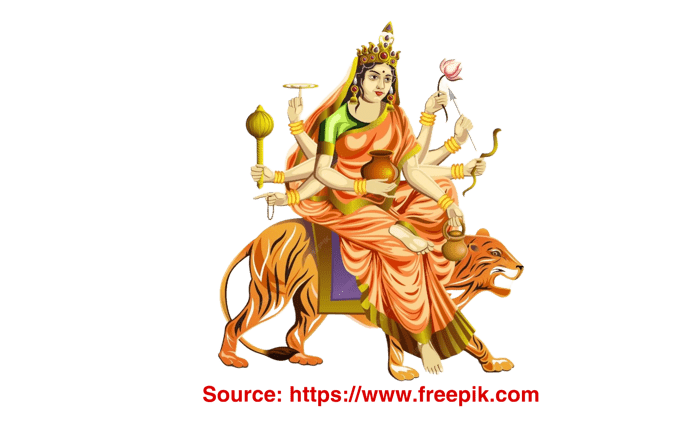The Nine Facets of Devi Durga: Know About Goddess Kushmanda
Goddess Kushmanda: The Divine Creator Who Brings Light and Prosperity
Navratri is one of the most revered Hindu festivals, celebrated across India and by Hindus worldwide. The nine-day festival is dedicated to worshiping the nine manifestations of Goddess Durga, each representing different powers and virtues. On the fourth day of Navratri, devotees offer prayers to Goddess Kushmanda, who is revered as the creator of the universe. Her name, derived from “Ku” (a little), “Ushma” (warmth or energy), and “Anda” (cosmic egg), signifies her role in the creation of the cosmos with her radiant smile. Goddess Kushmanda’s energy is believed to bring light to the universe, dispel darkness, and foster life and growth.
Mythological Significance of Goddess Kushmanda
In Hindu mythology, Goddess Kushmanda is said to be the creator of the universe. Before the existence of anything, the cosmos was nothing but an endless dark void. It was with her radiant smile that she manifested the first burst of light, which became the source of energy for the entire universe. She is believed to reside in the center of the sun and radiates energy to the cosmos. This powerful symbolism is associated with warmth, creation, and the beginning of all life forms.
Goddess Kushmanda is also credited with creating the three worlds — heaven, earth, and the underworld. She infused life into these realms and established the balance of the universe. As the divine creator, she holds the power to control time and space, ensuring harmony between the physical and spiritual dimensions.
Depiction and Symbolism of Goddess Kushmanda
Goddess Kushmanda is depicted as riding a lion, symbolizing her strength and courage. She is also known as Ashtabhuja Devi, or the goddess with eight arms. Each of her arms carries a symbolic item: the kamandalu (holy water pot), bow, arrow, lotus, mace, chakra (discus), jar of nectar, and japa mala (rosary). These items represent different aspects of her divine power.
- Kamandalu signifies the purity of thoughts and emotions.
- Bow and arrow symbolize her control over both the spiritual and material realms.
- Lotus represents purity, beauty, and self-realization.
- Mace indicates her authority and power to protect the righteous.
- Chakra (discus) symbolizes time, reminding us of the importance of balance in life.
- Jar of nectar is a sign of immortality and longevity.
- Japa mala (rosary) is a representation of her control over meditation and spiritual pursuits.
Her divine presence is also linked to the Anahata Chakra (heart chakra), the energy center in the human body associated with love, compassion, and emotional balance. Worshiping Goddess Kushmanda is believed to activate this chakra, allowing devotees to experience peace, love, and inner healing.
Spiritual Importance of Day 4 of Navratri
Support Independent Journalism? Keep us live.
The fourth day of Navratri is dedicated to seeking the blessings of Goddess Kushmanda. This day is significant for those who seek new beginnings, creative energy, and inner strength. Goddess Kushmanda is also associated with fertility and growth, making her worship highly auspicious for those hoping for success, prosperity, and the flourishing of ideas, families, and businesses.
Her influence is also believed to aid in the removal of negativity, darkness, and obstacles in life. Just as her smile created the universe, devotees hope her blessings will bring light and positivity into their lives. By worshiping her, people seek to tap into her creative energy and align themselves with the cosmic forces of the universe.
Rituals and Offerings to Goddess Kushmanda
The worship of Goddess Kushmanda on the fourth day of Navratri is marked by various rituals and offerings. Devotees begin their day with a bath, followed by prayers and offerings to the goddess. The color of the day is green, symbolizing growth, nature, and energy.
Devotees offer flowers, fruits, coconut, and sweets during the puja, with malpua (a sweet pancake) being a special offering to the goddess as it is believed to be her favorite. Incense sticks, lamps, and camphor are also lit during the ritual, symbolizing the dispelling of darkness and ignorance. Devotees chant mantras and sing hymns in praise of the goddess, seeking her blessings for happiness, health, and prosperity.
Some devotees observe a fast on this day, consuming only fruits or a single meal in honor of the goddess. Others engage in meditation and spiritual readings, aligning their hearts with the energy of creation and peace that Goddess Kushmanda embodies.
The Power of Goddess Kushmanda in Everyday Life
Goddess Kushmanda is more than just a symbol of creation. She is also a source of inspiration for embracing light and positivity in everyday life. Her radiant smile that birthed the universe is a reminder that even the smallest positive actions, such as a smile, can have far-reaching effects. This divine energy encourages individuals to embrace new beginnings and foster creative growth in their personal and professional lives.
Her connection with the Anahata Chakra reinforces the importance of maintaining emotional balance and opening oneself to love, compassion, and forgiveness. By connecting with the energy of Goddess Kushmanda, devotees are encouraged to lead a life filled with empathy, kindness, and emotional resilience.
The worship of Goddess Kushmanda on the fourth day of Navratri is a celebration of creation, light, and new beginnings. As the divine creator, her energy brings positivity, prosperity, and transformation into the lives of her devotees. Whether it is seeking her blessings for success in life or praying for emotional healing, Goddess Kushmanda is revered for her power to dispel darkness and negativity, helping individuals live a more fulfilled and peaceful life. Through her, we are reminded of the power of creativity, compassion, and the transformative strength of a single smile.


Comments are closed.